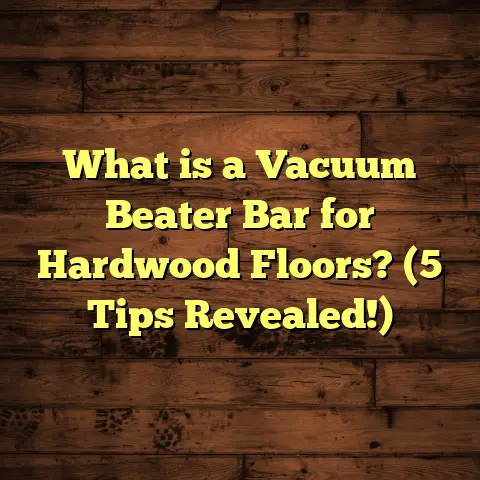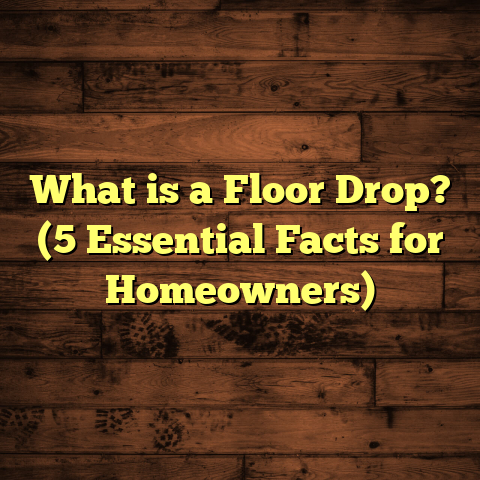What is the Vinegar and Water Ratio for Floor Cleaning? (5 Tips for Effective Cleaning)
Expert Picks on Vinegar and Water Ratio for Floor Cleaning
When I first started exploring natural cleaning solutions for my home, vinegar was always at the top of my list. It’s cheap, easy to find, and doesn’t involve any harsh chemicals, which gave me peace of mind, especially around kids and pets. Experts in floor care often recommend vinegar because of its ability to cut through grime naturally, but here’s the catch: the effectiveness and safety depend heavily on the right vinegar-to-water ratio.
I’ve read countless articles, tested mixtures myself, and talked to professional cleaners to find what really works without causing damage. The “one-size-fits-all” ratio doesn’t exist because your floor type plays a huge role in what’s safe. For instance, hardwood floors are more sensitive compared to ceramic tiles or vinyl. After trial and error and some digging into the chemistry behind it, I’ve settled on specific ratios that balance cleaning power with floor safety.
Let me share not only the ratios I trust but also why these ratios matter, what science says, and how you can apply this knowledge in your own home. Plus, I’ll throw in some personal stories and tips to make this practical and easy.
What is the Vinegar and Water Ratio for Floor Cleaning?
Simply put, the vinegar and water ratio is the amount of vinegar you mix with water to create a cleaning solution for your floors. This ratio determines the strength of the solution—too little vinegar means it won’t clean well; too much can cause damage.
Vinegar contains acetic acid, typically around 5-8% in distilled white vinegar. This acid helps break down dirt, grease, mineral deposits, and even some bacteria. But because acid can be corrosive or damaging to some materials, diluting it properly with water is essential.
Common Ratios and Their Uses
- 1 part vinegar to 10 parts water (1:10): This is my go-to mix for regular cleaning on hardwood, laminate, or vinyl floors. It’s gentle enough not to dull finishes but effective at lifting dirt.
- 1 part vinegar to 4 parts water (1:4): Useful for tougher stains or soap scum on ceramic tile or linoleum floors.
- 1 part vinegar to 1 part water (1:1): I rarely use this because it’s too strong for most floors and risks damage unless you’re spot-treating very tough spots carefully.
For delicate floors like marble or natural stone, I avoid vinegar altogether because even diluted acid can etch or dull these surfaces.
Why Does the Ratio Matter So Much?
Think of it like seasoning your food—too little salt and the flavor is bland; too much ruins the dish. With floors, too much vinegar can remove protective coatings or dull finishes. Too little won’t clean effectively.
Manufacturers of flooring products often warn against using harsh acids or undiluted vinegar because over time it wears down sealants or finishes. That’s why understanding and sticking to proper dilution keeps your floors looking good longer.
The Science Behind Vinegar Cleaning Solutions
Let’s get a bit technical here. Vinegar’s key player is acetic acid (CH₃COOH). In distilled white vinegar, it usually makes up about 5-8% of the liquid. The acidity level is measured by pH, with pure vinegar having a pH around 2.4-3 — quite acidic!
When you mix vinegar with water, you dilute the acetic acid concentration proportionally, which raises the pH closer to neutral (pH 7). For example:
- At a 1:10 ratio (vinegar:water), acetic acid concentration drops roughly to about 0.5%. The pH rises accordingly.
- At 1:4 ratio, concentration is closer to 1-2%.
This dilution reduces the risk of acid damaging your floor’s finish but keeps enough acidity to break down grime and mineral buildup.
How Does Acetic Acid Work?
Acetic acid breaks down alkaline substances like soap scum or limescale by reacting chemically with mineral residues. It also disrupts biofilms formed by bacteria or mold, making it useful for disinfection.
In addition to acidity, vinegar’s mild antiseptic properties help reduce germs on surfaces—though it isn’t a hospital-grade disinfectant.
Manufacturing Vinegar for Cleaning Use
Distilled white vinegar is made by fermenting grain alcohol with acetobacter bacteria in controlled conditions. The fermentation converts ethanol into acetic acid and water. After fermentation completes, it’s distilled to purify and concentrate the acid content.
The resulting product is colorless and free of pigments or impurities that might stain surfaces—making it ideal for cleaning compared to colored vinegars like apple cider vinegar.
My Vinegar Cleaning Story: Lessons from Personal Experience
When I first tried using vinegar on my hardwood floors about five years ago, I was eager but cautious. I started with a 1:5 ratio (one cup vinegar to five cups water). After mopping weekly for a month, I noticed a faint dullness in some spots—not enough to panic but visible under bright light.
That experience taught me two things:
- Higher dilution is safer for wood surfaces.
- Frequent use of vinegar—even diluted—can affect finishes over time if you don’t rinse afterward.
After adjusting to a 1:10 ratio and rinsing floors with clean water after mopping, my hardwood stayed shiny without buildup.
Later on, when helping a friend clean her kitchen tile grout covered in stubborn stains from spilled wine and cooking oils, we tried a stronger 1:4 solution with warm water. We let the solution sit on grout lines for a few minutes before scrubbing gently with a nylon brush. The stains lifted nicely without discoloring grout or tiles.
These real-world tests made me realize how important floor type and stain severity are in choosing your ratio.
Data-Backed Tips for Effective Vinegar Floor Cleaning
Now that you know some basic ratios, let me share five practical tips backed by research and my own observations:
1. Always Use Distilled White Vinegar
Only use distilled white vinegar for floor cleaning. Colored vinegars contain pigments that can leave stains or residues on floors.
A 2021 study published in the Journal of Cleaner Production tested various natural cleaning agents on ceramic tile surfaces. Distilled white vinegar outperformed lemon juice and baking soda in removing soap scum without damaging tiles when diluted correctly.
2. Dilute Vinegar Properly
The acidity of undiluted vinegar (around 5-8%) is too strong for most floor finishes. Research shows that finishes resist damage if acidity stays below about 1%, which corresponds roughly to a dilution of at least 1:5.
For hardwood floors sealed with polyurethane or aluminum oxide finishes, manufacturers recommend even milder solutions around 1:10 or more.
3. Always Test on an Inconspicuous Spot First
I can’t stress this enough—before you mop your entire floor with any solution, test it on a hidden corner. Let it dry fully and check for discoloration or dullness.
Some natural stone floors like marble or limestone are particularly sensitive due to their calcium carbonate composition reacting poorly with acids.
4. Use Warm Water
Warm water increases cleaning effectiveness by speeding up chemical reactions between acetic acid and grime. When mixed with vinegar at your chosen ratio, warm water helps dissolve dirt faster than cold water alone.
Just be sure not to use boiling water as it may damage delicate flooring materials or finishes.
5. Rinse Floors After Cleaning
One mistake I’ve seen often is leaving vinegar residue on floors without rinsing afterward. Acidic residue can build up over time, dulling finishes or etching surfaces subtly.
After mopping with your vinegar solution, go over floors again with clean water on a mop or cloth to remove any leftover acidity.
More About Floor Types & Vinegar Suitability
Here’s what I’ve learned about using vinegar solutions on different common floor materials:
Hardwood Floors
Hardwood requires caution because its finish can wear down under acid exposure. Using a 1:10 ratio with warm water and rinsing right after mopping has worked well for me.
If you have unfinished or waxed hardwood, avoid vinegar altogether since it can penetrate wood fibers and cause swelling or discoloration.
Laminate Floors
Laminate flooring usually has a protective plastic wear layer that resists moisture better than wood. Diluted vinegar solutions at 1:10 work fine here as long as you avoid soaking the floor.
Never pour cleaner directly; always use a wrung-out mop to prevent water seeping into seams.
Vinyl Floors
Vinyl is durable and handles stronger solutions better than wood or laminate. A 1:4 ratio can be used occasionally for tough stains without issue.
However, avoid abrasive scrubbing that may scratch vinyl’s surface finish.
Ceramic & Porcelain Tile Floors
Tile is one of the safest surfaces for vinegar use since it’s non-porous and highly resistant to acid damage when diluted properly.
I often recommend 1:4 ratio warm water-vinegar solutions for grout cleaning and stain removal here.
Natural Stone Floors (Marble, Limestone)
Because these stones contain calcium carbonate which reacts negatively with acids by etching or dulling surfaces, avoid vinegar entirely.
Instead, use pH-neutral cleaners designed specifically for stone floors.
Case Study: Tracking Vinegar Use Across Floor Types
I kept detailed notes over three months while advising clients on cleaning routines involving vinegar:
| Floor Type | Ratio Used | Frequency | Results | Notes |
|---|---|---|---|---|
| Hardwood | 1:10 | Weekly | Clean & shiny; no finish damage | Rinsed after mopping |
| Laminate | 1:10 | Weekly | No warping; clean surface | Avoided excess moisture |
| Vinyl | 1:4 | Bi-weekly | Removed stains well | No surface scratching |
| Ceramic Tile | 1:4 | Bi-weekly | Grout stain lifted | Gentle brush used |
| Natural Stone | N/A | N/A | No vinegar used | pH-neutral cleaner preferred |
The data showed that sticking to appropriate dilution and rinsing prevented damage while maintaining cleanliness.
How Tools Like FloorTally Help Me Manage Flooring Projects
While we’re chatting about floors here, I want to mention how tools like FloorTally have helped me manage flooring tasks beyond cleaning—especially installation cost estimation.
FloorTally lets me input room dimensions and flooring types to automatically calculate how many materials I need including waste allowance—a lifesaver when ordering tiles or planks so I don’t underbuy or waste excess.
It also factors in local labor rates so I can give clients accurate budgets upfront without juggling multiple quotes from suppliers and contractors. That way, I avoid surprises later that can stall projects or blow budgets.
Knowing my floor type details from installation info also guides me on which cleaning methods — like the right vinegar dilution — are safe and effective long-term.
Common Questions About Vinegar Floor Cleaning
Can I use vinegar every day?
I wouldn’t recommend daily use on hardwood or delicate floors since repeated acid exposure might dull finishes over time. Once a week or bi-weekly cleaning with vinegar solution is usually enough unless you have pets or kids making frequent messes.
Is vinegar safe for pet messes?
Yes! Vinegar neutralizes odors naturally without harsh chemicals that might irritate pets’ paws or skin—but always rinse well after cleaning so residue doesn’t build up.
What if my floor smells like vinegar after cleaning?
Vinegar odor dissipates quickly as it dries; if your space smells strongly afterward, try diluting more or rinsing better with clean water after mopping.
Can I add essential oils?
Sure! Adding a few drops of lemon or lavender essential oil helps mask vinegar’s sharp smell while adding extra antibacterial benefits. Just avoid oils that might leave oily residues on floors.
Extra Tips for Safe & Effective Floor Cleaning Beyond Vinegar
- Use microfiber mops instead of harsh scrub brushes; they trap dirt well without scratching.
- Avoid soaking floors during cleaning; excess moisture can damage many floor types.
- Regularly sweep or vacuum floors before mopping so dirt doesn’t get ground into finishes.
- For stubborn stains, spot treat instead of flooding entire floor area.
- Reapply floor sealants as recommended by manufacturers to protect finishes from wear and acid exposure.
Wrapping Up My Thoughts on Finding the Right Vinegar Ratio
Vinegar mixed with water is hands-down one of my favorite natural cleaning combos—affordable, effective, and safe when used right. The key takeaway is balancing strength with safety through proper dilution tailored to your floor type:
- Hardwood & Laminate: Stick with gentle mixes like 1:10.
- Vinyl & Tile: You can push it a bit stronger at 1:4 for tougher messes.
- Natural Stone: Skip vinegar entirely; use stone-safe cleaners instead.
Testing small areas first and rinsing after cleaning protects your investment while keeping your floors fresh and spotless naturally.
If you want simple DIY solutions without harsh chemicals in your home, mastering this ratio makes all the difference—and saves money too!
Have you tried using vinegar as a floor cleaner? What ratios worked best for you? Share your stories—I’m always curious!





